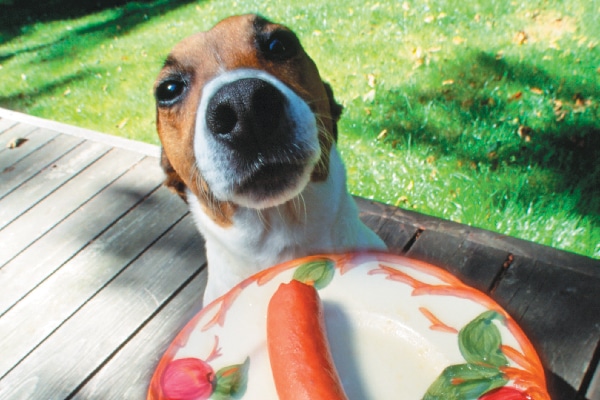I used to call my dog the canine vacuum. He kept my carpets clean, sucking up any food I accidentally dropped (as long as it wasn’t something healthy like fruits or vegetables). In retrospect, I should not have been so cavalier. Many foods humans eat are toxic to dogs. But let’s face it: Most of us enjoy slipping our dogs a bit of what we eat now and then. And that can be OK as long as we know what foods and amounts are safe. So, when it comes to human food for dogs, what can dogs eat and what should dogs definitely avoid? Can dogs eat bread? What about fruits and vegetables? And can dogs eat nuts or fish?
Human food for dogs — the basics
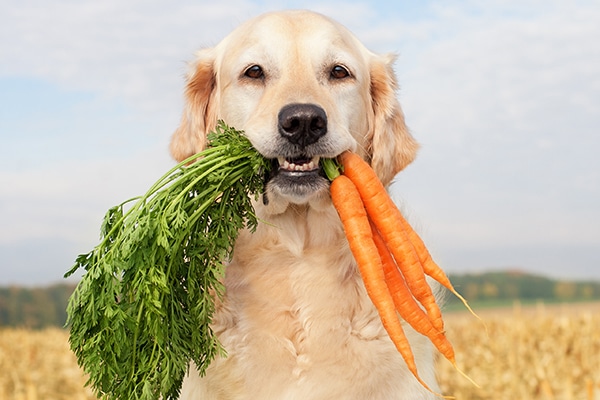
“There are some key differences,” says Dr. Deborah Linder, DVM, research assistant professor at Cummings School of Veterinary Medicine at Tufts University in North Grafton, Massachusetts.
Dogs and humans digest and metabolize food differently, and a dog’s digestive system cannot break down some of the foods people eat, Dr. Linder warns. And we all know that some of the things we eat are not particularly healthy.
Most commercial dog foods provide a balanced diet with all the nutrients a dog needs. As long as your dog’s essential needs are met through an easily digested quality dog food, he shouldn’t need anything more. But you can feed your dog some other foods as healthy, low-calorie snacks.
“It’s perfectly safe to give up to 10 percent of the total calories from treats without unbalancing the diet,” says Dr. Linder, a veterinary nutrition specialist and diplomate of the American College of Veterinary Nutrition.
Before sharing your table scraps, be aware that there are concerns about human food for dogs beyond toxicity: allergic reactions, raw vs. cooked, bacterial infections from E. coli and Salmonella, weight gain, elevated salt levels, choking hazards and bones that can break teeth or splinter, causing internal blockages or punctures.
“Anything you give should be fully edible and not cause an obstruction,” Dr. Linder says. The keys to safely feeding your dog are education, moderation and introducing new foods slowly to monitor for adverse effects.
Remember: Each dog is unique. Factors like size, weight, age, breed, medical conditions and activity level affect what foods and amounts you should feed, so always check with your veterinarian before trying to feed any human food to your dog. As Dr. Linder says: “Know your pet.”
Human food for dogs — what’s safe to share … and what’s not?
So which of our favorite people foods can we safely share with our four-legged friends? Here’s our lowdown on what your chow hound can chow down:
Can dogs eat bread?
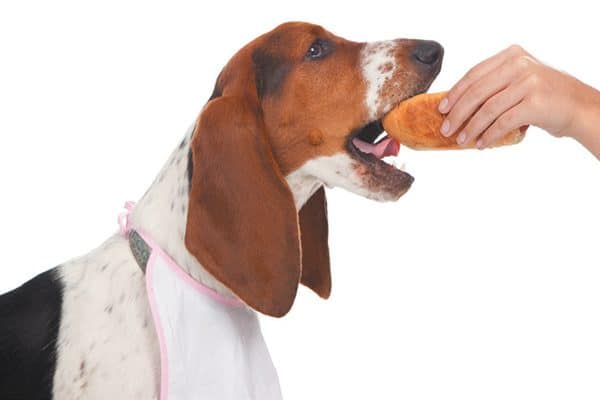
Bread is the staff of life, and yes, dogs can eat it. Barley, rye and wheat do contain the protein gluten, but gluten sensitivity is uncommon in dogs (with the exception of a rare genetic disorder in Irish Setters).
While dogs can develop an allergy to any protein source, gluten poses no higher risk than other proteins. Unless your dog has a gluten sensitivity, it’s OK to feed plain white, whole-wheat or whole-grain bread with no spices or raisins (raisins are toxic to dogs).
As with any baked good, check the ingredients list on the package before serving.
On the other hand, raw dough that contains yeast is a no-no. Fermenting yeast cells produce alcohol (alcohol is toxic to dogs), and the dough can expand internally.
Can dogs eat dairy?
Lactose intolerance poses the main concern with dairy products. Lactose, a sugar found in milk and milk products, can be difficult for some dogs (and people) to digest. As long as your dog is not lactose intolerant, milk is OK in small quantities.
Cheese — which many dogs love — also is OK, but due to its high fat and salt content, consider a low-fat cheese, such as mozzarella. Eggs that are thoroughly cooked are an easily digested protein source; never feed raw eggs due to the risk of Salmonella.
Avoid ice cream. Although there can be lactose issues with yogurt, it’s a better option that offers calcium and can aid digestion. Choose plain yogurt without added sugar or xylitol, a sugar substitute that is toxic to dogs.
A great option — some companies actually make ice cream-style treats specifically for dogs. When in doubt, consult your veterinarian.
Can dogs eat fish?
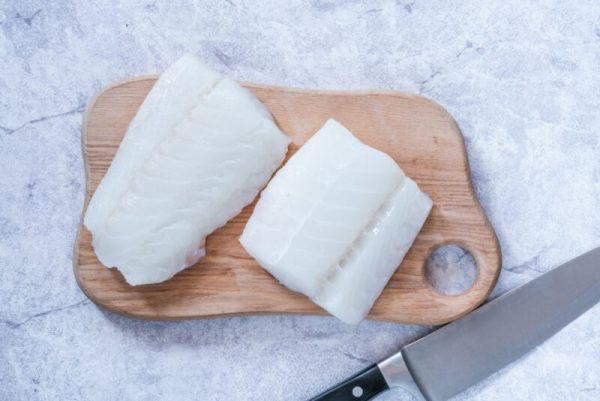
Fish can be a good source of omega-3 fatty acids, which some studies show act as an anti-inflammatory and can help with joint pain.
Salmon should be thoroughly cooked to kill parasites and bacteria; be sure to remove the bones.
Shrimp also is OK if fully cooked and served plain without the shell. Fresh cooked tuna that has been deboned is fine; canned tuna packed in water and served plain is OK, too.
Read more about which seafood is safe for dogs.
Can dogs eat fruit?
Many fruits can be a healthy, low-calorie snack for dogs. They are water- and nutrient-dense foods rich in vitamins, minerals, fiber and antioxidants. Feed fresh fruits, as many canned fruits are packed in sugary syrup. Frozen fruits can be OK, too, as long as they are thawed first.
Always wash fresh fruits and remove rinds, skin, peels, shells, cores, pits, stems, leaves and seeds, as they are choking hazards and, in some cases, can be toxic to dogs. With larger fruits, cut them into pieces before serving. Be aware that citric acid can cause stomach upset in some dogs. And never feed your dog wild berries that are not definitively identified and safe.
As long as you follow the above precautions, you can feed your dog several fruits, including apples, apricots, bananas, blackberries, blueberries, cantaloupe, coconut, mango, oranges, pineapple, pumpkin, strawberries and watermelon.
Although the meat of cherries is not poisonous to dogs, the fruit’s small pit can cause big problems by becoming lodged in the throat or digestive tract. Best to avoid this bite-sized hazard and its preserved sugary form: maraschino cherries.
These fruits should never be fed to dogs: grapes, lemons, limes and raisins.
Read more about which fruit dogs can eat.
Can dogs eat meats?
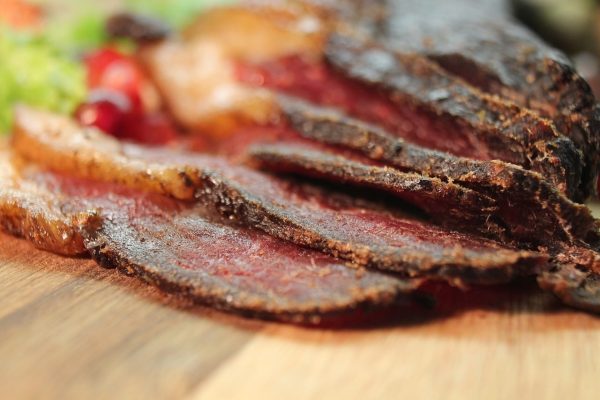
Like their wild canid ancestors, dogs can eat meat. It’s a good source of protein — with precautions. Fresh, lean meat is preferable, and all meat should be thoroughly cooked to prevent food-borne illnesses from parasites and bacteria (best not to cook in microwave ovens, as they can cook unevenly).
Grind the meat or cut it in bite-sized chunks to help prevent choking, and do not feed bones. Remove fat and skin, and serve plain, as sauces, gravies and seasonings might include ingredients your dog should not have. Beef, chicken (watch out for chicken bones, though) and turkey are fine. Pork and pork products like bacon and ham might best be avoided due to fat, salt and high calorie counts.
Hot diggity dog, what could be better for a dog than a hot dog? Well, lots of things. Hot dogs are a category unto themselves, as easily fitting under “Meats” as “Salty Foods” alongside processed lunch meats (think “bologna”). Dogs can eat hot dogs, but there’s a difference between “can” and “should.”
Despite their name, hot dogs are not good for dogs. They can contain lots of sodium (added both for flavoring and curing), fat, sugar and garlic (garlic is toxic to dogs).
And while hot dogs are considered a ready-to-eat meat, the U.S. Food and Drug Administration notes on its website: “Although hot dogs are fully cooked, those at increased risk of foodborne illness should reheat hot dogs … until steaming hot before eating due to the threat of listeriosis.”
What’s more, hot dogs pose a choking hazard. If you feed hot dogs to your dog, check the ingredients list on the package and also look to see that they are uncured; reduced fat; made from grass-fed beef; and free of preservatives, artificial colors and artificial flavors. Cook and cut them before serving.
Can dogs eat nuts?
Nuts are a good source of protein, but they can be high in calories and salt, hard to digest and a choking hazard. Even nuts that are safe for dogs — like shelled cashews and shelled peanuts — should be unsalted and limited in quantity.
Others, such as almonds, pecans, pistachios and walnuts, are best avoided. And definitely say nuts to macadamia nuts — they are toxic to dogs.
Just as peanuts are safe for dogs, so is peanut butter. And it’s a favorite for many dogs (and a people favorite to watch a dog smack off the roof of his mouth). The best peanut butter to feed is plain, unsalted and raw (meaning it’s made with unroasted peanuts). Most importantly, be certain it does not contain the sweetener xylitol, which is toxic to dogs.
Read more about which nuts dogs can eat.
Can dogs eat prepared foods?
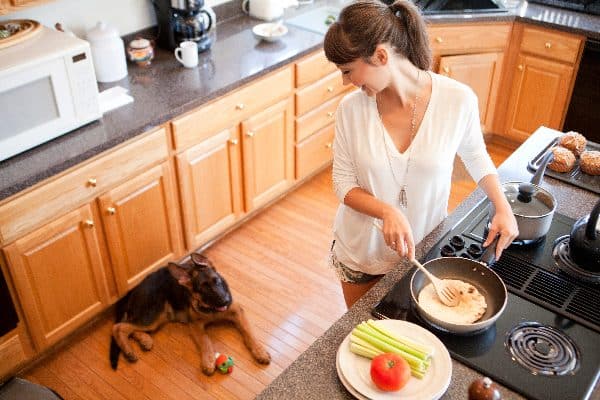
Here’s the dish on prepared dishes: It might be tempting to feed a dog from your plate, but it’s not a good idea. Many ingredients in prepared meals (whether takeout or delivery, restaurant leftovers, store-bought or even your neighborhood potluck party) can be harmful to dogs, including chives, garlic and garlic powder, leeks and onions and onion powder.
And recognizing garlic and onion poisoning can be tricky because symptoms can take days to develop. Because you don’t know what ingredients might have gone into that soup, sauce, salad dressing, marinade, pizza and toppings, stuffed potato or confection, curb the desire to offer your dog prepared foods.
You can have your cake and eat it, too, but your dog can’t, and that’s just the way the cookie crumbles.
Can dogs eat popcorn and other salty foods?
You don’t want a salty dog. While dogs need some salt, too much salt not only will make your dog thirsty, it also can lead to dehydration, hypertension (high blood pressure), kidney failure, heart disease and sodium poisoning.
Avoid excessively salty foods and snacks (particularly for dogs with a heart condition) like processed lunch meats, pickles, potato chips, pretzels, and, yes, fast foods (including French fries).
Not to ruin all the fun, popcorn is a snack dogs can eat if it’s air-popped, unsalted and unbuttered. Watch for un-popped kernels that can be a choking hazard and get caught in teeth.
Can dogs eat vegetables?
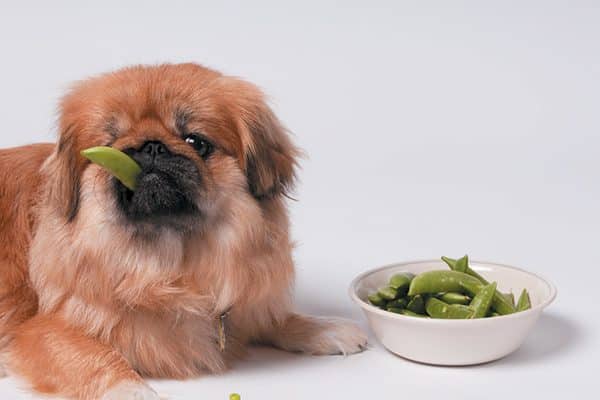
Like fruits, vegetables that are safe for dogs are healthy, water- and nutrient-dense, low-calorie foods packed with vitamins, minerals, fiber and antioxidants. Plain, fresh vegetables are preferable, as many canned vegetables contain added salt, but frozen veggies can work as long as they are thawed or cooked.
Always wash fresh vegetables first; most can be served raw or cooked, and steaming is a good cooking method. Grate larger vegetables or cut them in small pieces to avoid choking. The list of safe vegetables is long and includes broccoli, carrots, cauliflower, celery, cucumber, green beans, green peas, lettuce and zucchini.
Corn also is safe for dogs, but not corn on the cob — the cob is a choking hazard. Dogs can eat red tomatoes as long as they are ripe, but discard the leaves and stem.
Mushrooms cut both ways. Store-bought mushrooms are considered safe for dogs, but never feed wild mushrooms. There are about 10,000 known species of mushrooms, some of which are poisonous, so don’t take a chance with any found fungi. Given this, you might want to avoid mushrooms altogether.
Read more about which vegetables dogs can eat.
Can dogs eat chocolate?
While people love chocolate (and studies suggest it has human health benefits), sad to say this people favorite is not sweet on dogs. Chocolate (as well as cocoa and coffee) contains compounds called methylxanthines that are toxic to dogs.
The darker the chocolate (bittersweet and semisweet dark chocolate, cocoa powder and unsweetened baking chocolate), the more dangerous, but even milk chocolate and white chocolate should not be given to dogs.
Chocolate ingestion by pets is so common that the ASPCA Animal Poison Control Center puts chocolate in its own category separate from other foods. Last year, the total number of calls the center received about chocolate worked out to nearly 50 a day, ranking chocolate fifth among the ASPCA’s 2017 Top Pet Toxins.
Be vigilant, especially with so many occasions popular for giving chocolate: Valentine’s Day, Easter, Halloween and Christmas. Think of it this way: Now you can have that chocolate all to yourself.
The 14 things dogs should never eat
- Alcohol and Products Containing Alcohol
- Caffeine
- Chives
- Chocolate
- Garlic and Garlic Powder
- Grapes
- Leeks
- Lemons
- Limes
- Macadamia Nuts
- Onions and Onion Powder
- Raisins
- Xylitol (a sugar substitute)
- Yeast dough
What does human food for dogs have to do with canine obesity?
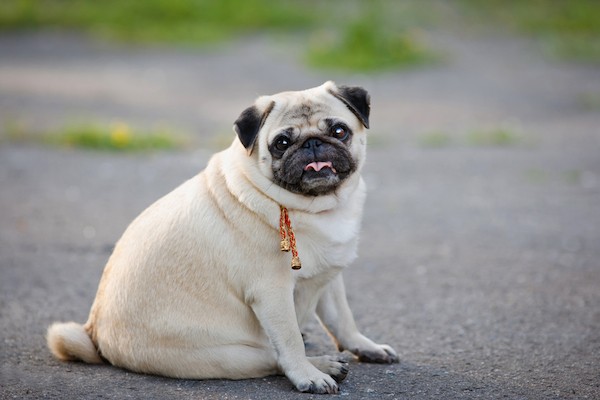
It’s not just what you feed your dog, but how much. Let’s chew the fat about the weighty issue of obesity.
Fifty-six percent of dogs in the United States are overweight or obese, according to a 2017 clinical survey by the Association for Pet Obesity Prevention (APOP).
That record number equals an estimated 50 million dogs, with more than 36 percent of those overweight and nearly 20 percent obese. And it’s a growing problem.“It’s the most common health threat,” says Dr. Ernie Ward, DVM, founder of the Ocean Isle, North Carolina-based APOP, which has been tracking rising pet obesity rates since 2006.
“It’s not just an aesthetic or unsightly condition,” Dr. Ward says. Fat tissue pumps out thousands of potentially harmful chemicals, hormones and compounds that can lead to cancer, high blood pressure, kidney failure, heart disease, reduced life expectancy, orthopedic disease, chronic inflammation, and respiratory and skin disorders, he says. Extra weight also impacts a dog’s quality of life, such as the ability to go for a walk or climb stairs.
Obesity is a complex disorder linked to many factors, including genetics, but overfeeding and under exercising are serious problems.
There is some good news. Dr. Ward says sharing some human foods with dogs, in moderation, might benefit your dog. “Dogs and people co-evolved eating many of the same things,” Dr. Ward says. It comes down to understanding “the nutritional value of the food,” he says, and taking into account your dog’s unique nutritional and caloric needs.
Dr. Ward advocates what he calls “the hybrid menu”: a combination of quality commercial dog food and whole foods (unprocessed, unrefined, without additives and artificial substances).
Because highly processed packaged food undergoes high heat and pressure that can alter fats and proteins, Dr. Ward suggests blending in things like lean protein sources and fresh, crunchy vegetables.
“By adding some of these whole foods, you’re getting all the complex fibers, all the real protein and fats that are contained in the natural state, which is ideal for digestibility,” Dr. Ward says. “Simply adding some broccoli, celery, zucchini to their regular kibble every day can have tremendous health impacts over time. Those little, simple things can make a big difference.”
Read more about what human food for dogs on Dogster.com:
- Sardines for Dogs? Can Dogs Eat Sardines?
- Olive Oil for Dogs — 8 Reasons to Add It to Your Dog’s Diet
- Coconut Oil for Dogs? 10 Reasons to Try It
St. Louis-based freelance writer Martha M. Everett has lived on both coasts covering everything from Washington to Westminster. More interesting, her Keeshond-mix rescue, Trooper, helped set a World Record for the Most Dogs in Costumed Attire.
Featured Image Credit: EuToch | Getty Images.

